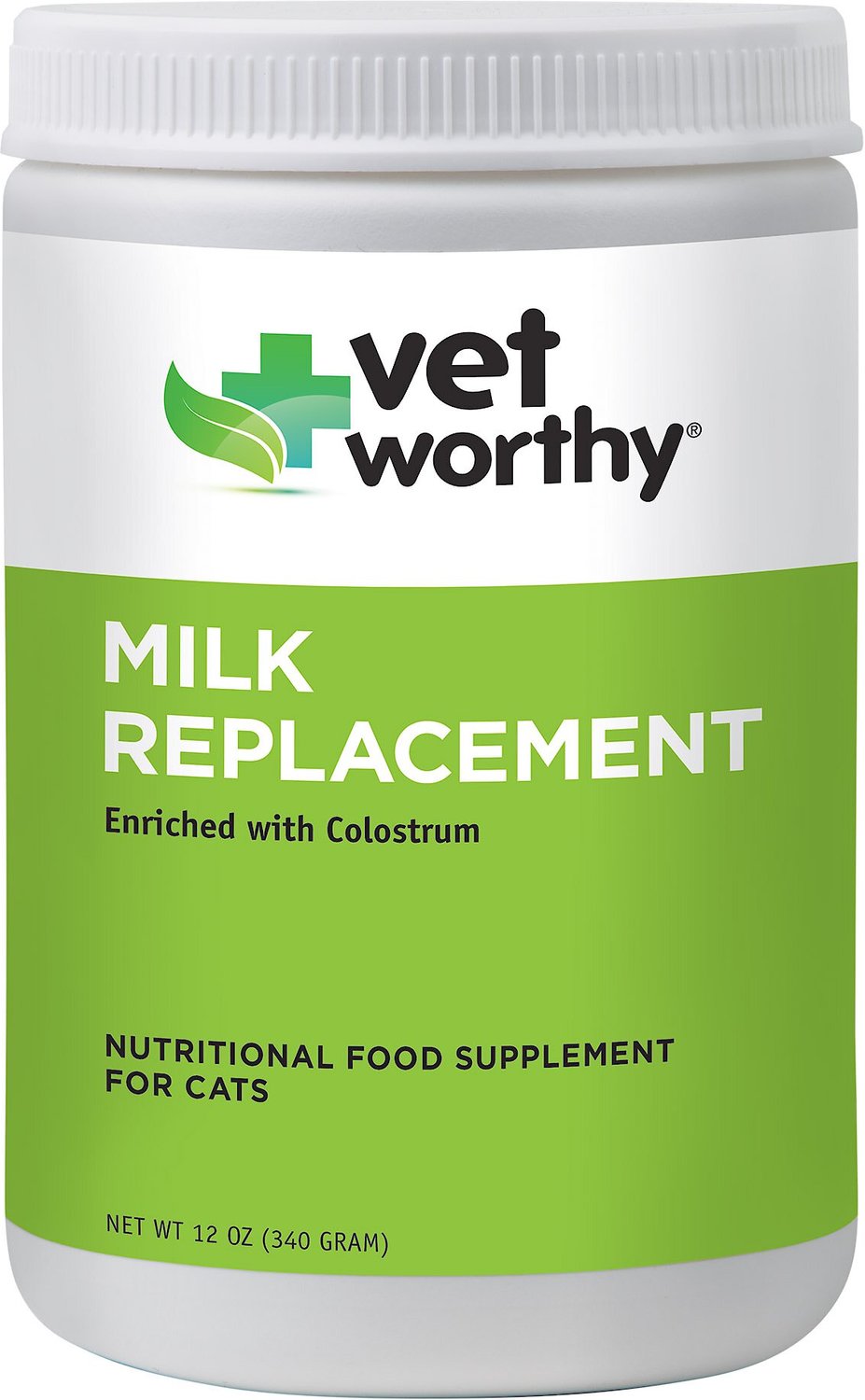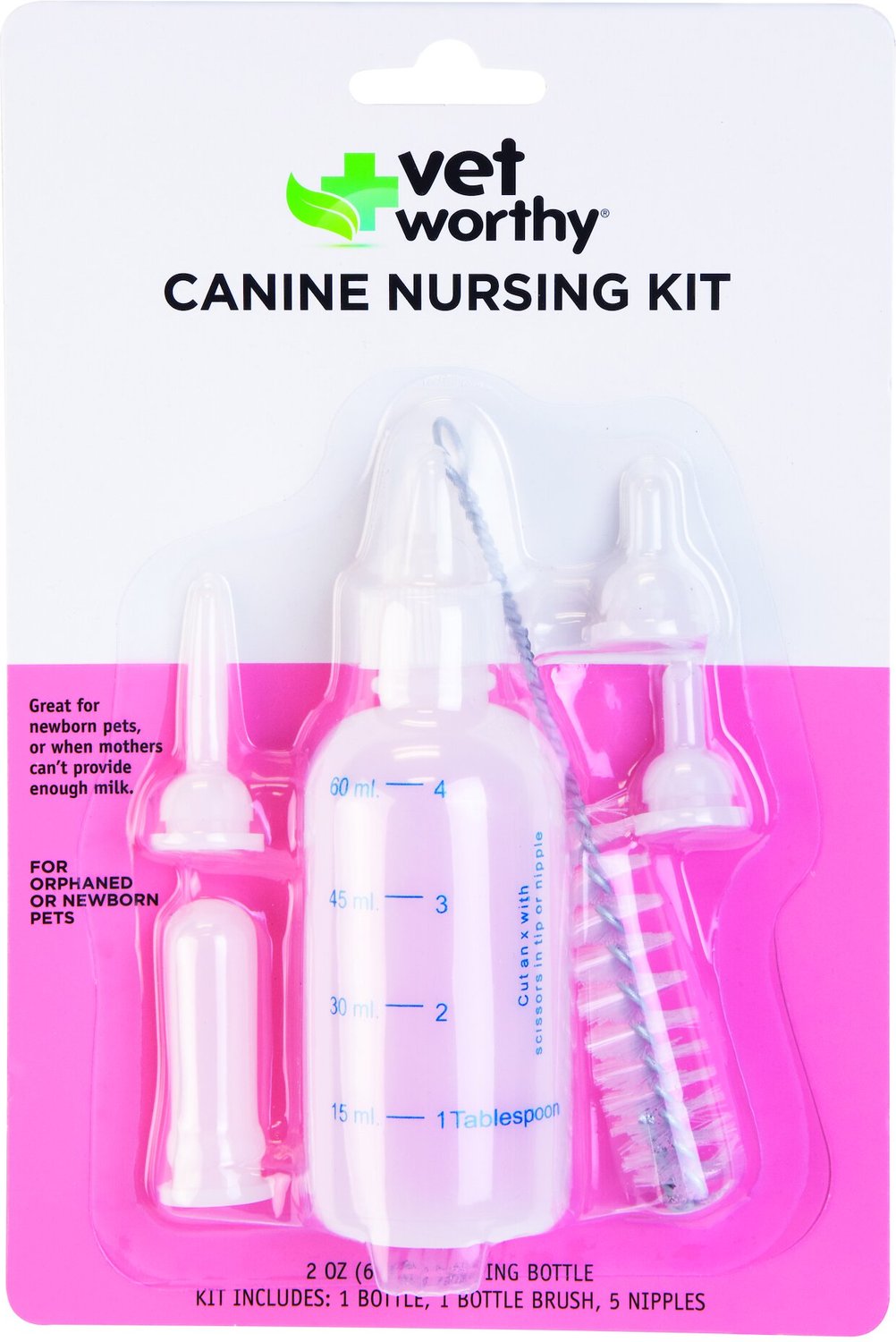Just like human babies, kittens go through numerous developmental changes from birth to adulthood. For proper development, growing kittens need appropriate nutrition. You have to tread a very fine line when it comes to kitten feeding. If their nutritional needs are not met, they will suffer from malnourishment; in contrast, if they are getting calories in excess, they will suffer from obesity. This is why vets advise cat owners to feed their kittens according to a kitten feeding chart, making sure they are getting a balanced diet.
Feeding a Kitten
Bringing a kitten home or waiting for your pregnant cat to complete the gestation period and give birth to a litter of kittens, can be super exciting and all, but taking care of the nutritional needs can be challenging, especially if the mother cat is not around and the baby kitten is too young to eat solid food. You have to take the place of the mama cat—feeding, grooming, and loving them.
Feeding kittens well—really well—is a bit more complex than most people think.
In this article, we will provide you with a kitten feeding chart by age, addressing all your concerns: How much do kittens eat a day? How often should kittens eat? When do kittens start eating? And at what age can a kitten eat dry food? And when can kittens eat adult food?
Kitten’s Nutritional Requirements Evolve Over Time
As the newborn kitten moves from infancy to adulthood, and from there to senior years, her nutritional needs will change. Kittens’ diet must be changed according to their evolving nutritional needs so that our purring fellas remain healthy at every developmental stage.
Feeding a Newborn Kitten
There is nothing more nutritious for baby kittens than mother’s milk. If the mother cat is around, kittens should feed on her milk. Kittens start nursing as soon as 1 to 2 hours after birth and the kitten weaning process starts between four to six weeks and some kittens may even take up to 10 weeks.
But if the baby kitten is an orphan or you have rescued her from the street, and the mother cat is not around, you will have to play the role of the mama cat. You will have to groom and feed the kitten.
Can I Give Cow Milk to a Newborn Kitten?
No! Baby kittens cannot have cow milk.
After rescuing a baby kitten, the first thing we do is serve her some dairy milk.
We have all been there, we all have done that. But contrary to popular belief, cow milk is harmful to cats. Cats are lactose intolerant, lacking the enzymes necessary for the digestion of lactose sugar present in dairy milk. This is why almond milk is used as an alternative for cats and lactose intolerant humans. However, it is advised not to feed almond milk or any other human foods safe for cats to eat to young kittens as it could upset their stomach that is not fully developed yet. Even when feeding almond milk or any other cat-safe human food to an adult cat, one should be extremely careful and moderate.
But when it comes to baby kittens, in the absence of mother’s milk, they should neither be given cow milk nor almond milk but only the KMR formula. You will have to bottle-feed the baby kitten. Take your cat to the vet for examination and ask him for advice about the KMR formula and how frequently you should be feeding the kitten. Usually, baby kittens are supposed to be fed every 2 hours. You should feed them until you think their tummy is full.
Best Kitten Milk Replacer for Kittens
Overwhelmed by the plethora of KMR formulae available in the market? Well, worry not. Look at the following kitten milk replace formula for kittens.
Get this and you won’t have to worry about what to feed a newborn kitten for around a month. Revival Animal Health’s KMR for kittens is the best kitten milk replacer for the first 35 days of your cat in this world.
Kitten Nursing Kit
To bottle-feed your kitten, you are also going to need a kitten nursing kit. For that, look at the following products:
Kitten Feeding Chart
To give you an idea about how much your kitten should be consuming during the different stages of her life, we have compiled a kitten feeding chart by weight and age below. If you are bottle-feeding your kitten, you can still use this chart as a kitten bottle-feeding chart. Please note that this is a general guide, and your cat may have a weight above or below the average. It is best to discuss it with your vet if you think that your cat is not growing properly or is growing obese.
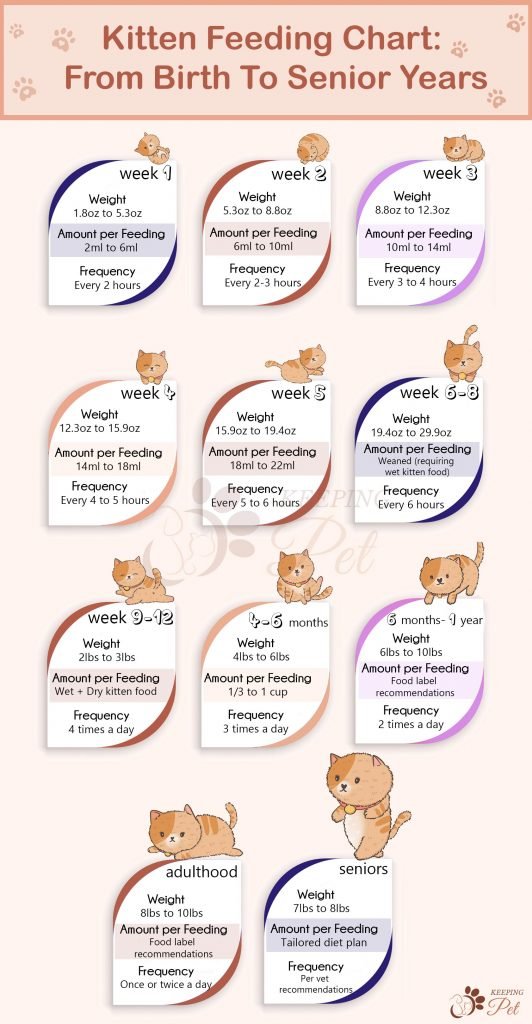
Use the above kitten feeding chart by age and weight to determine how much and how often you need to feed your kitten.
Feeding a 1-Week Old Kitten
The average weight of a newborn kitten ranges between 1.8 to 5.3 ounces, and after a week, they weigh between 5.3 to 8.8 ounces. You should weigh your kitten daily to make sure that she is growing properly. If her weight is way more or less than the average, you should get in touch with your vet. The vet might ask you to bring her for an examination or suggest a change in formula.
How Much Do Newborn Kittens Eat?
To meet their nutritional needs, kittens are supposed to nurse for around 45 minutes, every two hours, during the first week. As the kittens’ eyes are shut during the first week, you will have to do the feeding yourself with a bottle. The kitten should consume around 2 to 6 ml of KMR per feeding. Feeding for 45 minutes every 2 hours is a lot of time that you may not have. Therefore, it is advised that you keep the kitten with a surrogate lactating cat if the mother cat is not around. You will still have to ensure that the surrogate cat is treating the kitten as her own child.
At this stage, kittens cannot urinate or defecate on their own, so you will have to stimulate them to urinate and defecate. You will also have to keep them clean by using pet wipes, specially made for cats, or a soft wet cloth when the kitten has finished her business. Never use baby wipes on kittens or even adult cats.
Feeding a 2-Week-Old Kitten
During this period, the kitten’s eyes will be opened completely, and you won’t have to sit there through the whole feeding session. Where most kittens open their eyes by day 10, some may take even a bit longer. However, if your kitten has not opened her eyes after 2 weeks, you should take her to a veterinarian.
The kitten will be able to locate the nipple on the bottle and suck on it. However, you will still have to help the kitten with urination and defecation. You will also be responsible for cleaning them at this stage. Cleaning would make sure that they don’t develop urine or fecal scald.
How Much Do 2-Week-Old Kittens Eat?
In week two, you should increase the amount of KMR formula per feeding but will decrease the frequency. A two-week-old kitten should be consuming around 6 to 10 ml per feeding every 2-3 hours.
Feeding a 3-Week-Old Kitten
A three-week-old kitten should be weighing between 8.8 to 12.3 ounces. Your kitten will start developing baby teeth at the front of their mouth at this stage, but you should not give them anything other than KMR. With their eyes fully opened and ears unfolded, kittens will start exploring nearby places. They will also be able to urinate or defecate on their own, but you will still have to do the cleaning duty.
How Much Do Kittens Eat at 3 Weeks?
During this stage, the kitty should consume around 10 to 14 ml of KMR formula per feeding every 3 to 4 hours.
Feeding a 4-Week-Old Kitten
During this period, your fur ball will start developing those sharp canines. At this stage, in addition to urinating and defecating on her own, your fur ball will also start grooming herself. However, you might still have to do some grooming.
How Much Do 4-Week-Old Kittens Eat?
A 4-week-old kitten would be heavy—weighing around 12.3 to 15.9 ounces. At this stage, feeding will be less frequent, but the amount per feeding will be more. A 4-week healthy kitten should be fed around 14 to 18 ml of KMR every 4 to 5 hours
Feeding a 5-Week-Old Kitten
On average, a 5-week-old kitten should be weighing between 15.9 to 9.4 ounces. If you open your cat’s mouth, you will see that she has started developing premolars. Seeing your cat developing teeth, you might be tempted to give her something other than KMR, but you are advised not to. Wait for a week—you can start transitioning your cat from KMR to wet kitten food in the coming week.
How Much Do 5-Week-Old Kittens Eat?
A 5-week-old kitten should be fed 18 to 22 ml of KMR every 5 to 6 hours.
6 to 8-Week Old Kitten
If kittens are being taken care of by the mother cat, the weaning process naturally begins during the sixth week, and the mother cat starts bringing some fresh solid food for the kittens. You should emulate this and start transitioning your kitten from KMH to kitten food. During the sixth week, the teeth development will be near completion. With time, you can gradually begin increasing the viscosity of the kitten food, making it more gruel in nature by decreasing the amount of water.
Be Careful About Weaning
When can kittens eat food? When can they switch from their mother milk to eating food?
The weaning process usually starts during week 6, and the kittens are fully weaned off by week 7. But it is not a hard and fast rule—depending on your kitten’s weight and overall health, weaning can take place later, according to PetMD. It is important to get advice from your vet or use your best judgment. If the kitten is underweight, you should continue feeding her the KMR formula; if she stops eating or starts losing weight during the weaning process, you may continue feeding her the formula for another 4 to 5 days, or maybe longer before getting into weaning again. The weaning process should be gradual. You should start by giving her kitten food soaked in kitten formula.
9 to 12-Week-Old Kitten
At this stage, your cat would have fully developed her baby teeth—all set to gobble up that protein-rich dry kitten food. However, if your kitty seems not interested in the dry food, you can add some water to it or maybe keep giving her the wet kitten food. One of the benefits of kitten food is that it will keep her hydrated. During this age, your cat will develop her personality and her food preferences will stay with her for the rest of her life. So if you do not want her to become a finicky eater, you should not spoil her by giving her treats more often.
How Much Do 9-Week-Old Kittens Eat?
9-week old kittens are growing faster, so they need a lot of nutrients. But since they have small stomachs, you can keep on feeding them 4 times a day. You can keep feeding your cat four times a day until they are older than 4 months.
If you are giving your cat dry food, you can simply pour dry food into your kitty’s bowl. But if your kitten is into wet cat food, you will have to refrigerate the food between feedings and then warm it up before pouring it into your kitty’s bowl.
4 to 6 Months Old Kitten
During this developmental stage, your kitten will have an increased appetite; they will always look for something to munch on. However, you should not spoil her by keeping her bowl always full. Instead, you should feed them only three times a day. At this age, kittens start developing a routine and would expect you to pour the food into their bowl at that specific time.
You should keep track of their weight, making sure that your cat is not growing overweight or underweight. Usually, during this stage, kittens are fed about 1/3 to 1 cup at each feeding, 3 times a day. It is advised that you check your cat’s weight every week and adjust the amount you put in their bowl accordingly. You should also be careful about the nutrient profile of the food that you are pouring into your kitten’s bowl—as too little protein can lead to the development of health problems.
Likewise, do not change your kitten’s food unless it is necessary. That is, either its nutrient profile does not fit the nutritional requirements of your kitten, or the vet has suggested some other food.
6 Months to 1-Year-Old Kitten
On average, a healthy cat should grow around 1 pound every month. So by the age of 6 months, your cat should be weighing around 6 pounds. However, during a 10 to 12-month period, you might notice that your cat is not gaining much weight. According to WebMD, the ideal weight of a domestic cat should be around 10 pounds, which can vary depending on your cat breed. For instance, a healthy Maine Coon can weigh around 25 pounds and a Siamese can weigh as low as 5 pounds and be perfectly healthy.
For 6 – 12 months old kittens, two meals per day are ample for meeting their needs. The amount per feeding should be according to the food label recommendations. However, you should make sure that the food you are pouring into your kitten’s food bowl meets the nutrient requirements of your fur ball.
During this period, your cat will reach puberty. Depending on her breed, she may hit puberty as early as 4 months or as late as 9 months. If you are not planning on breeding your cat, you should get her spayed before her first heat of the estrous cycle, or the male kitten in the litter may get your cat pregnant, and then you might have to consider spaying your pregnant cat. Spaying improves the life expectancy of our cats by decreasing the risk of deadly feline diseases, such as ovarian and breast cancer in females and testicular cancer in males.
When to Switch From Kitten Food To Adult Cat Food
Kittens grow fast—really fast. Before you know it, they will be hitting puberty and reaching adulthood. Moving into adulthood, the nutritional requirements of cats change diametrically. This is the reason that switching from kitten food to adult food is a crucial decision for a cat’s health—if switched earlier, your cat may start losing weight and becoming lethargic; if delayed, the cat might grow obese.
How Long Should Kittens Eat Kitten Food?
Most experts suggest that you keep on feeding your kitten the kitten food until their first birthday celebration. This is not a hard and fast rule, though. Depending on your cat’s health and breed, you might have to switch to adult cat food during the 8th month, and for big cats like Norwegian Forest Cat, you might have to wait for as long as their second birthday.
Feeding Adult Cats
As discussed above, different cats reach adulthood at different ages. But once in adulthood, their nutritional requirements decrease greatly as compared to kittens. It is advised that once your cat has entered adulthood, you should not only switch from kitten food to adult food but also reduce the amount per feeding and frequency.
How Much Should an Adult Cat Eat?
According to Dr. Kallfelz, “once cats reach adulthood, once a day feeding is fine as long as they are healthy and have no disease problems suggesting a reason to feed differently.” You can also feed them twice a day and reduce the amount per feeding accordingly.
Differing Nutritional Needs of Kittens and Adult Cats
If you have cats of different ages—baby kittens, adult, and senior cats—at your home, at some point you might have pondered: Can kittens eat adult cat food? Can I feed my kitten adult cat food? Or can kittens eat adult wet food?
The answer to these questions is hidden in the differences between the nutritional needs of kittens and adult cats.
The nutritional requirements of kittens differ greatly from those of adult cats. Kittens have special nutritional requirements as they have to go through a phase of explosive growth, with numerous developmental changes following. Kittens need more calories than adult cats because they are not only more active but are also gaining weight day by day. On the contrary, adult cats have little to no activity. They sleep all day—on average, a cat sleep from 16 to 20 hours a day.
Because of the development changes that kittens go through and their increased activity, vets suggest that they have more frequent meals. Jennifer Larsen, the nutritional consultant at the Veterinary Medical Teaching Hospital at the University of California Davis, says that where young kittens have the same fatty acids and vitamin requirements as an adult cat, they need more protein—kittens should receive around 30 percent of their energy from proteins.
Purina ONE Indoor Advantage Adult Cat Food
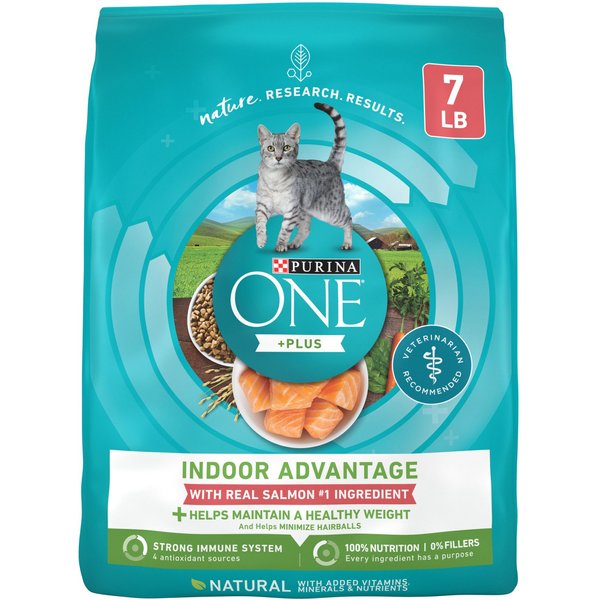
|
|
|
Feeding a Senior Cat
In her early senior years, your cat may appear young and full of energy, as if she is still too young to be called a senior cat. But this does not mean that you keep on feeding your cat the same adult cat food. Depending on the overall health of your cat, her food may be requiring an overhaul.
According to WebMD, a 12-year-old cat is equivalent to a 64-year-old human. Just like humans start falling prey to different ailments in their later years, cats also develop several health issues, such as kidney issues and joint diseases. Depending on the overall health of senior cats, there is a need to make a tailored diet plan, after discussing it with the vet.
Iams Proactive Health Healthy Senior Dry Cat Food, Chicken Flavor
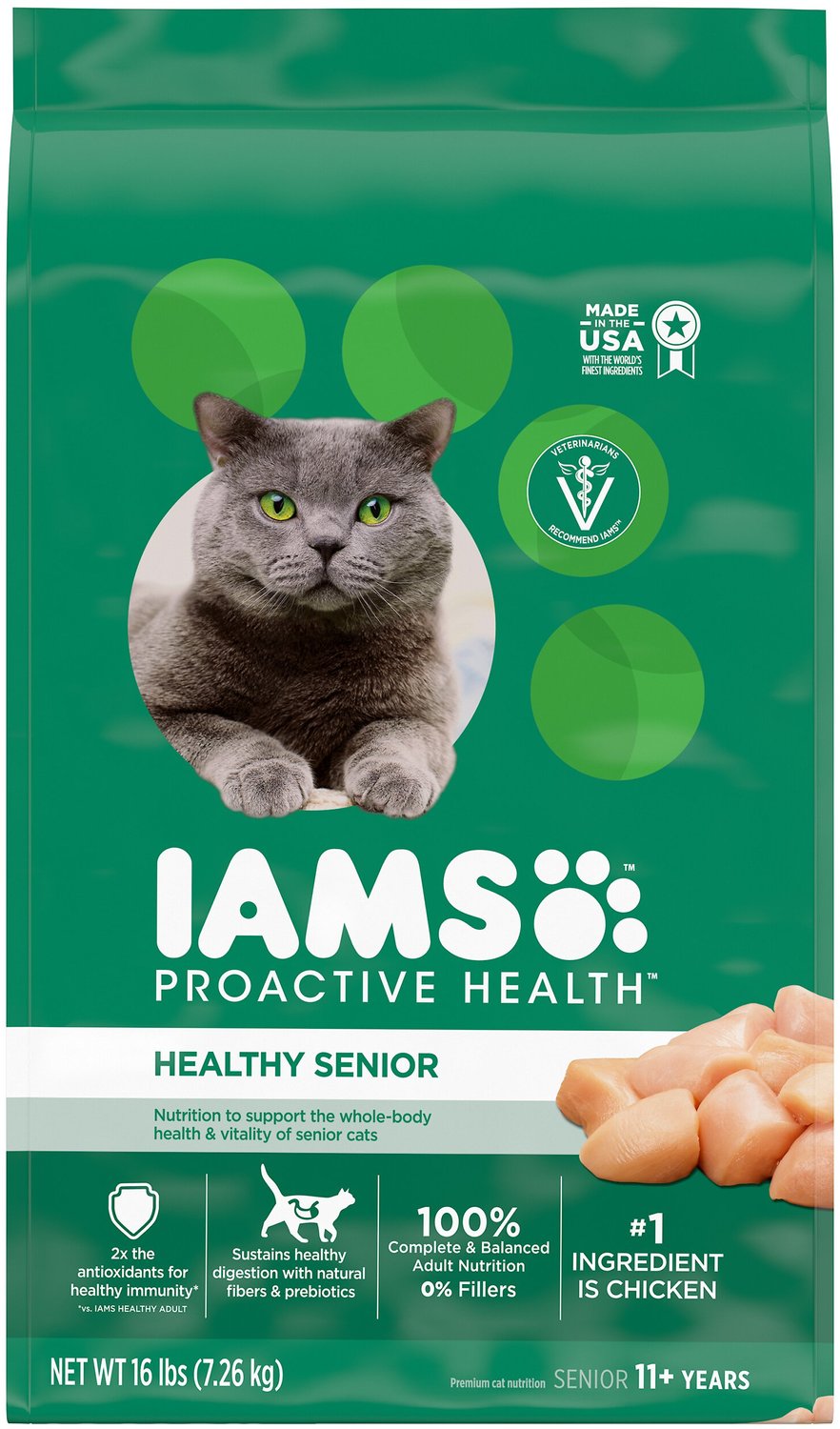
|
|
|
Feeding a Pregnant Cat
Pregnant cats need higher caloric intake, as they have to eat not only for themselves but also for the kittens developing inside of them. Cats are pregnant for around 9 weeks, and if you take a look at the week-by-week cat pregnancy timeline, you will notice that pregnant cat appetite increases as the pregnancy progress. Therefore, it is strongly advised that you switch to quality food as soon as pregnancy is diagnosed. Therefore, it is crucial that you familiarize yourself with the signs of cat pregnancy so that you could tell if your cat is pregnant and put her on quality kitten food. You should also learn what more is there to caring for a pregnant cat beyond switching to kitten food.
Feeding a pregnant cat, you should keep in mind that as the kittens develop, they start pressing against the cat’s stomach, decreasing the cat’s capacity to eat food in one go. Therefore, you should provide small but more frequent meals to your pregnant cat, especially in the latter stages of pregnancy. Most people make the mistake of switching back to normal cat food as soon as the cat has delivered the litter. But you should know that you should continue feeding your cat quality kitten food as long as the cat is nursing.
How to tell if your kitten’s nutritional needs are being met or not? This can be hard. But worry not, all you need is a kitten growth chart to check if your cat is growing optimally. You should weigh your kitten every week. If the kitten seems to be growing according to the kitten growth chart, her nutritional needs are being met. If the kitty seems to be underweight, there is a possibility that her dietary needs are not being met properly, you should consult a vet.
If you are a Chewy-Autoship customer, you can try Chewy’s Connect with Vet and consult a licensed veterinarian at no cost and discuss if you need to make a change in your kitty’s diet.

